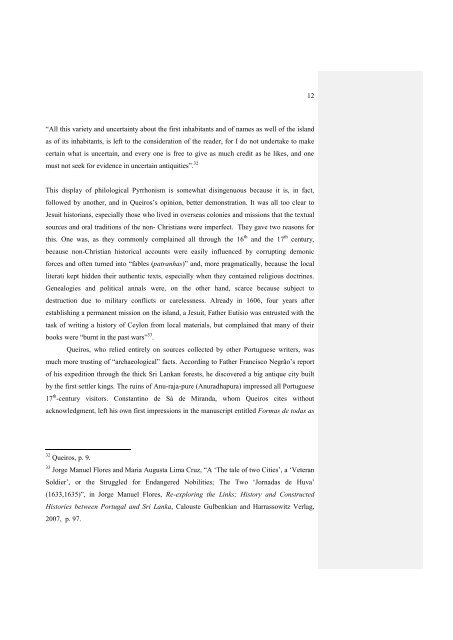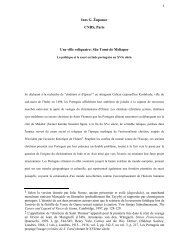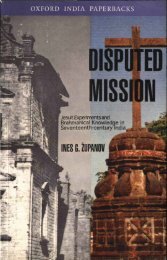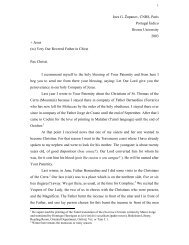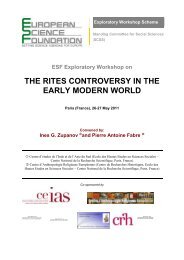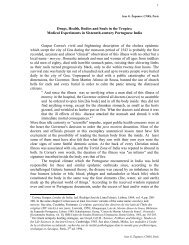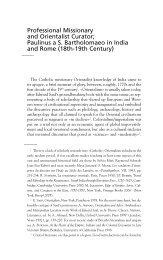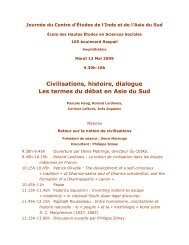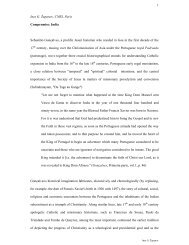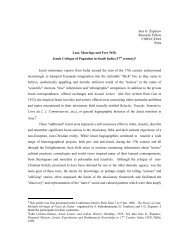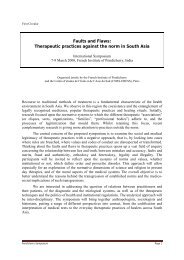Jesuit Orientalism; - Ines G. Županov
Jesuit Orientalism; - Ines G. Županov
Jesuit Orientalism; - Ines G. Županov
You also want an ePaper? Increase the reach of your titles
YUMPU automatically turns print PDFs into web optimized ePapers that Google loves.
12<br />
“All this variety and uncertainty about the first inhabitants and of names as well of the island<br />
as of its inhabitants, is left to the consideration of the reader, for I do not undertake to make<br />
certain what is uncertain, and every one is free to give as much credit as he likes, and one<br />
must not seek for evidence in uncertain antiquities”. 32<br />
This display of philological Pyrrhonism is somewhat disingenuous because it is, in fact,<br />
followed by another, and in Queiros‟s opinion, better demonstration. It was all too clear to<br />
<strong>Jesuit</strong> historians, especially those who lived in overseas colonies and missions that the textual<br />
sources and oral traditions of the non- Christians were imperfect. They gave two reasons for<br />
this. One was, as they commonly complained all through the 16 th and the 17 th century,<br />
because non-Christian historical accounts were easily influenced by corrupting demonic<br />
forces and often turned into “fables (patranhas)” and, more pragmatically, because the local<br />
literati kept hidden their authentic texts, especially when they contained religious doctrines.<br />
Genealogies and political annals were, on the other hand, scarce because subject to<br />
destruction due to military conflicts or carelessness. Already in 1606, four years after<br />
establishing a permanent mission on the island, a <strong>Jesuit</strong>, Father Eutísio was entrusted with the<br />
task of writing a history of Ceylon from local materials, but complained that many of their<br />
books were “burnt in the past wars” 33 .<br />
Queiros, who relied entirely on sources collected by other Portuguese writers, was<br />
much more trusting of “archaeological” facts. According to Father Francisco Negrão‟s report<br />
of his expedition through the thick Sri Lankan forests, he discovered a big antique city built<br />
by the first settler kings. The ruins of Anu-raja-pure (Anuradhapura) impressed all Portuguese<br />
17 th -century visitors. Constantino de Sá de Miranda, whom Queiros cites without<br />
acknowledgment, left his own first impressions in the manuscript entitled Formas de todas as<br />
32 Queiros, p. 9.<br />
33 Jorge Manuel Flores and Maria Augusta Lima Cruz, “A „The tale of two Cities‟, a „Veteran<br />
Soldier‟, or the Struggled for Endangered Nobilities; The Two „Jornadas de Huva‟<br />
(1633,1635)”, in Jorge Manuel Flores, Re-exploring the Links; History and Constructed<br />
Histories between Portugal and Sri Lanka, Calouste Gulbenkian and Harrassowitz Verlag,<br />
2007, p. 97.


